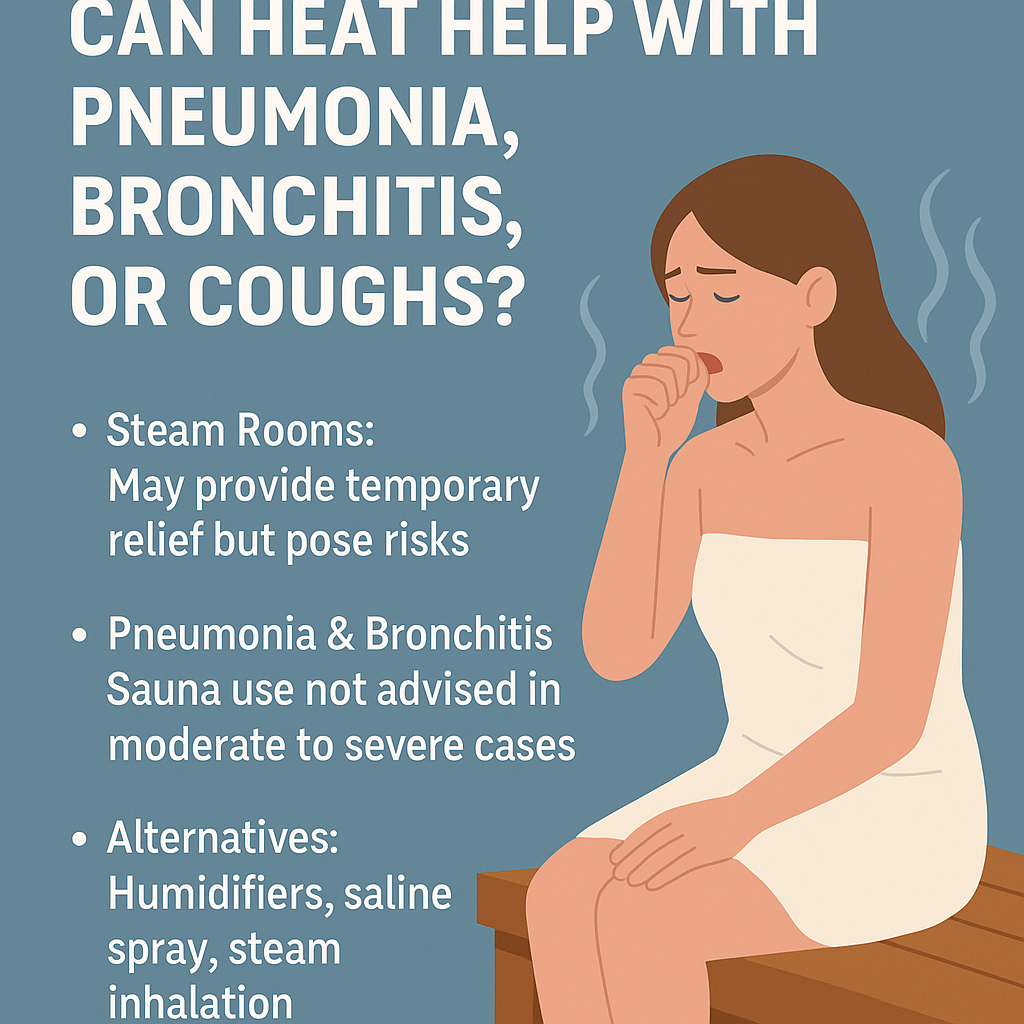Saunas and Respiratory Infections: Can Heat Help with Pneumonia, Bronchitis, or Coughs?
Introduction: Navigating Sauna Use During Respiratory Illness
Sunmmary: Saunas and steam rooms may offertemporary symptom relief for mild respiratory issues like cough or chest congestion, but they arenot safe for use during active pneumonia or severe bronchitis. Heat exposure can relax airways and promote mucus clearance, but for serious infections, it’s crucial to avoid additional physical stress. Always consult your doctor.
The soothing warmth of a sauna or the humid heat of a steam room might feel like the perfect remedy when you’re coughing or congested. But when respiratory infections likepneumonia orbronchitis strike, can sauna therapy help—or hurt? This guide breaks down the science, risks, and recommendations for using saunas during respiratory illness.
Table of Contents
-
How Heat Affects the Respiratory System
-
Steam Room for Cough Relief: Does It Work?
-
Saunas and Pneumonia: What You Need to Know
-
Sauna Use During Bronchitis: Helpful or Harmful?
-
Infrared vs. Steam for Respiratory Conditions
-
Key Risks and Medical Warnings
-
When You Can Safely Use a Sauna with a Cough
-
Alternative Therapies for Safer Relief
-
FAQs
-
Final Thoughts
1. How Heat Affects the Respiratory System
Saunas and steam rooms create heat stress that stimulates circulation, dilates blood vessels, and temporarily opens up the respiratory tract. Two key biological mechanisms contribute to this effect:
-
Vasodilation: The body's response to heat includes the expansion of blood vessels, which increases blood flow. This enhanced circulation can help deliver more oxygen and immune cells to areas of inflammation in the respiratory tract, facilitating healing and symptom relief.
-
Mucociliary Clearance: Heat and humidity stimulate the cilia—the microscopic hair-like structures that line the airways—to move more effectively. This helps transport mucus and trapped pathogens out of the lungs and sinuses, making breathing easier.
In addition, the heat from saunas may trigger a mild, controlled hyperthermic state, mimicking fever and promoting animmune response. This can include increased production of white blood cells and activation of heat shock proteins, which aid in cellular repair and immune signaling.
For individuals experiencing congestion or a lingering dry cough, these processes can lead to:
-
Thinning of mucus for easier expulsion
-
Relaxation of airway muscles
-
Temporary relief from chest tightness
However, these benefits apply primarily tonon-infectious or resolving stages of illness and should not be mistaken for curative treatments. Saunas and steam rooms create heat stress that stimulates circulation, dilates blood vessels, and temporarily opens up the respiratory tract. For individuals experiencing congestion or a lingering dry cough, this can lead to:
-
Thinning of mucus for easier expulsion
-
Relaxation of airway muscles
-
Temporary relief from chest tightness
However, these benefits apply primarily tonon-infectious or resolving stages of illness.
2. Steam Room for Cough Relief: Does It Work?
Yes, steam rooms are known to provide relief forirritating or dry coughs, especially when caused by:
-
Post-viral irritation
-
Allergies
-
Mild bronchial inflammation
Steam inhalation can moisturize and soothe irritated bronchial passages and help loosen phlegm. But for deeper infections like pneumonia, this effect isnot curative.
Keywords Answered: is steam sauna good for cough
3. Saunas and Pneumonia: What You Need to Know
Using a sauna or steam room while experiencingpneumonia—a serious lung infection—is generallynot recommended. Pneumonia can cause high fever, fatigue, shortness of breath, and impaired oxygen exchange. Adding heat stress to an already burdened respiratory and circulatory system may worsen these symptoms.
It’s important to distinguish betweenbacterial andviral pneumonia:
-
Viral pneumonia may result in a gradual onset of fatigue, cough, and congestion. While mild viral cases may resolve with rest, the immune system is still actively engaged, and the added stress from sauna heat could lead to dehydration or fainting.
-
Bacterial pneumonia tends to be more severe, often requiring antibiotics and hospitalization. The use of a sauna during bacterial pneumonia is especially risky, as elevated body temperatures and fluid loss can compound complications.
Risks include:
-
Overheating or fainting due to elevated heart rate
-
Difficulty breathing in hot, humid air
-
Worsened dehydration, which can interfere with recovery
-
Increased cardiovascular strain in already weakened patients
If you've recently recovered from pneumonia, consult your healthcare provider before returning to sauna sessions. Most experts recommend waitingat least 2–4 weeks post-recovery, once fever has subsided and energy levels return.
Keywords Answered: is a steam room good for pneumonia, can you go in a sauna with pneumonia, is steam room good for pneumonia, is a sauna good for pneumonia Using a sauna or steam room while experiencingpneumonia—a serious lung infection—is generallynot recommended. Pneumonia can cause high fever, fatigue, and oxygen deficiency. Adding heat stress to a compromised respiratory and circulatory system may worsen symptoms.
Risks include:
-
Overheating or fainting due to elevated heart rate
-
Difficulty breathing in hot air
-
Worsened dehydration
Wait until full recovery and medical clearance before using a sauna again.
Keywords Answered: is a steam room good for pneumonia, can you go in a sauna with pneumonia, is steam room good for pneumonia, is a sauna good for pneumonia
4. Sauna Use During Bronchitis: Helpful or Harmful?
Withmild viral bronchitis, short and gentle heat exposure—particularly in a steam room—can help with mucus drainage and soothe inflammation. However, if the bronchitis isbacterial, accompanied by fever, or affects breathing, sauna use can be risky.
Early-Stage vs. Late-Stage Bronchitis:
-
Early-stage bronchitis often features an acute dry or mildly productive cough, fatigue, and inflammation of the bronchial tubes. During this phase, sauna use should be avoided, especially if symptoms are escalating or accompanied by fever.
-
Late-stage or resolving bronchitis, where mucus is loosening and symptoms are waning, may benefit from short steam sessions that support mucus clearance and airway relaxation. Gentle sauna use at this stage may also help ease lingering tightness in the chest.
Avoid sauna use if:
-
You are on antibiotics and feel fatigued
-
Your breathing worsens in heat
-
You feel dizzy, weak, or dehydrated
Always monitor how your body responds, and consult your healthcare provider before resuming heat therapy after illness.
Keywords Answered: is a sauna good for bronchitis? Withmild viral bronchitis, short and gentle heat exposure—particularly in a steam room—can help with mucus drainage and soothe inflammation. However, if the bronchitis isbacterial, accompanied by fever, or affects breathing, sauna use can be risky.
Avoid sauna use if:
-
You are on antibiotics and feel fatigued
-
Your breathing worsens in heat
-
You feel dizzy, weak, or dehydrated
Keywords Answered: is a sauna good for bronchitis
5. Infrared vs. Steam for Respiratory Conditions
Choosing the right type of sauna depends on your symptoms, sensitivity to heat, and stage of recovery. Below is a breakdown of common sauna types and their effects on the respiratory system.
| Type | Temperature Range | Humidity Level | Ideal For | Avoid When |
|---|---|---|---|---|
| Steam Room | 110–120°F (43–49°C) | High (100%) | Moisturizing airways, loosening mucus | High fever, pneumonia, severe fatigue |
| Infrared Sauna | 120–150°F (49–65°C) | Low (10–20%) | Gentle body warming, easing muscle tension | Active infection or dizziness |
| Dry Sauna | 160–200°F (71–93°C) | Very low (<10%) | Improving circulation, general detox | Dry cough, dehydration, respiratory distress |
-
Steam rooms deliver a warm, moist environment that helps break up mucus and relieve nasal or chest congestion, but can feel stifling during acute respiratory distress.
-
Infrared saunas are less intense in air temperature but penetrate the body more deeply. This type is more suitable during recovery stages when comfort and gradual re-acclimation are priorities.
-
Dry saunas offer a more intense heat with little humidity. While they may help with detoxification and circulation, they can worsen symptoms like dry cough or dehydration.
Each type offers unique benefits and risks, so choosing the appropriate sauna experience should be based on your current health condition and consultation with a healthcare provider.
| Type | Ideal For | Avoid When |
| Steam Room | Moisturizing airways, loosening mucus | High fever, pneumonia |
| Infrared Sauna | Gentle body warming, relaxation | Active infection or fatigue |
| Dry Sauna | Circulation, general detox | Dry cough, dehydration |
Steam rooms are most useful for surface-level congestion. Infrared saunas may be tolerable during recovery but not during peak infection.
6. Key Risks and Medical Warnings
Using heat therapy during an active respiratory infection can lead to:
-
Increased inflammation
-
Strained cardiovascular function
-
Risk of fainting or collapse
-
Delayed healing if the immune system is stressed by overheating
Never use a sauna if you are experiencing:
-
Fever above 100.4°F
-
Severe chest pain or labored breathing
-
A persistent, dry, or hacking cough
7. When You Can Safely Use a Sauna with a Cough
-
Your cough isresidual or mild, not accompanied by infection
-
You are no longer experiencing fever or weakness
-
You are well-hydrated and cleared by a doctor
-
You use the sauna for no more than15–20 minutes
-
You avoid extreme temperature changes (no cold plunges afterward)
8. Alternative Therapies for Safer Relief
If you're still in the peak of a respiratory infection, consider the following alternatives to sauna use:
-
Steam inhalation at home with essential oils (like eucalyptus or peppermint): This provides targeted humidity that helps loosen mucus and reduce inflammation in the upper respiratory tract.
-
Warm compresses on the chest: These increase blood flow to the area and can relieve muscle tension and mild chest pain associated with persistent coughing.
-
Saline nasal rinses: Help flush out irritants, allergens, and infectious agents from the nasal passages, supporting sinus drainage and easing congestion.
-
Warm herbal teas (e.g., ginger, licorice root, chamomile): These can soothe the throat, reduce coughing reflex, and offer mild anti-inflammatory and antioxidant benefits.
These methods support respiratory function by promoting mucus clearance, reducing inflammation, and enhancing comfort—all without the physiological stress that sauna use may impose during active illness. If you're still in the peak of a respiratory infection, consider:
-
Steam inhalation at home with essential oils
-
Warm compresses on the chest
-
Saline nasal rinses to relieve sinus pressure
-
Warm herbal teas like ginger or eucalyptus
These offer a gentler way to relieve symptoms without taxing your system.
9. FAQs
Q: Is it safe to use a sauna if I have walking pneumonia?
A: No. Even mild pneumonia limits oxygen exchange. Heat can worsen your symptoms.
Q: What kind of sauna is best for chest colds?
A: Steam rooms for mucus-heavy colds; infrared for post-cold recovery.
Q: When can I return to sauna use after pneumonia?
A: Once your fever is gone and you’ve received medical clearance—typically 2–4 weeks post-recovery.
10. Final Thoughts
While saunas and steam rooms offer excellent relaxation and immune-boosting benefits, they arenot appropriate during active respiratory infections like pneumonia or severe bronchitis. Listen to your body, consult your doctor, and wait until recovery before stepping back into the heat.










